|
THE CARTRIDGE COLLECTOR'S EXCHANGE |
| Contents
Cartridge
Lists
Prior Picture Pages:
Links to Other Sites
Cartridge Collectors Organizations:
Auctions:
Books:
Other Collector's Sites:
|
Home of the Old Ammo Guy's Virtual
Cartridge Trading Table Featuring a wide range of antique, obsolete, and modern ammunition for collectors Picture Page January 2006 A box of UMC bullets revisited......
Here's a box of 25 UMC two groove hollow point lead bullets that may be
familiar to those who have been following my picture pages for a while. I
included a picture of this box sometime in 2002, I think, perhaps a little
earlier. Unfortunately, I didn't keep copies of my first picture pages, so I
can't say for sure just when it was. At the time, I asked if anyone had ever
seen a .44-40 WCF loaded with a hollow point lead bullet. I didn't get a
response; I think they are pretty unusual, as I have never seen one. I have
only recently run across something close, however, which suggests I may have
been looking for the wrong cartridge all along. I've included a picture of a
.44-40
. . . . . . .
A seldom seen view of the .45 Brown Standard......
Here's a cartridge that you just don't see in every cigar box of mixed
cartridges. This is the .45-100 Brown Standard, made for use in the J. H.
Brown Standard Military Rifle. A total of twenty of the Brown rifles were
handmade for the 1883 international rifle team. It was a full-stocked single
shot rifle based on a modified Sharps action. The cartridge used an unheadstamped, Berdan primed, flat base
2.6" Sharps case and a special 550 grain paper patched bullet with an
unusual profile made by H. F. Clark of Pohkeepsie, N.Y. Unlike most patched
bullets, the patch on Mr. Clark's bullet does not cover the base, perhaps
for the purpose of leaving the raised H.F. CLARK PO'KEEPSIE, N.Y. mark
that he put on each one exposed. While the cartridge is quite rare, pictures
of it are
An original box of these cartridges is pictured on page 26 in the January 1969 issue of The Gun Report. It is a poor quality picture which will not reproduce well; the label reads: 10 CARTRIDGES / PRODUCED EXPRESSLY FOR / Brown's Standard Military Rifle / MANUFACTURED BY THE / BROWN STANDARD FIRE ARMS CO / NEW-YORK A similar cartridge, the .450-2 6/10" match, was produced by Eley for use in a falling block, single shot target rifle made by Fraser of Edinburgh, Scotland. This cartridge, like the Brown Standard, used the 2.6" Sharps case and a patched bullet that closely resembled the profile of the Clark bullet. I don't know which came first, but the two cartridges look so much alike it is fairly certain that one copied the other. Anyone with a collection of Robert Buttweilers cartridge auction catalogs can find the Fraser cartridge as lot 148 in volume II, no 3. > > >
And
speaking of the 1883 International Match Rifle Team, here's a copy of an
> > > > > > > Three early cartridges for the trapdoor carbine....
In January of 1874, production of the Benet-primed cartridge for the 1873
Springfield rifle and carbine commenced at Frankford Arsenal. The rifle
cartridge was loaded with 70 grains of black powder and a 405 grain three
groove lead bullet. In order to reduce recoil, the carbine cartridge was
loaded with 55 grains of powder. The same 405 grain bullet was used, seated
at the same depth as for the rifle cartridge, with seven pasteboard wads to
fill the empty space in the cartridge case between the powder and the base
of the bullet. Because the rifle and carbine cartridges looked the same
externally, it soon became apparent that some means of identification might
be helpful to distinguish between them once they were removed from their
boxes. In late July of 1874, on a trial basis, the arsenal began applying a
raised US CARBINE headstamp to the carbine cartridges. Three of these
headstamped cartridges are shown in the picture to the right. The headstamp
was applied using the case heading machine, but due perhaps to the added
cost and/or the complexity of the process, the trial lasted only one week.
As a result, a very limited number of these headstamped carbine cartridges
were produced. I suspect they were enough of a novelty at the time that not
many were fired, yet they still don't show up very often for sale. The
headstamps on these tend to be lightly stamped and are often almost
illegible; I have included below an enlarged view of the heads of the three
cartridges to make it a little easier to see the
. . . |

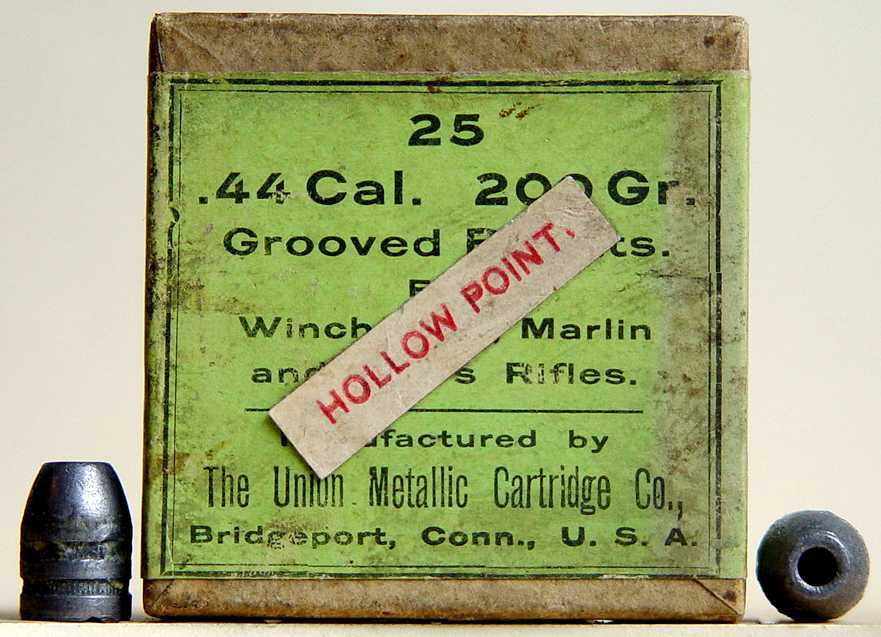
 black
powder cartridge that is sporting an uncommon REM-UMC 44 REM headstamp
and what appears to be one of these same hollow point lead bullets. This
headstamp, applied by Remington-UMC to what was otherwise the standard
.44-40 WCF black powder load, was intended to provide owners of the old
Remington Model 1875 and 1890 Single Action Army revolvers with a
recognizable cartridge that was safe to use in their black powder revolvers
after the introduction of smokeless powder. It shows no evidence of having
been reloaded, so I believe it is an original factory load.
black
powder cartridge that is sporting an uncommon REM-UMC 44 REM headstamp
and what appears to be one of these same hollow point lead bullets. This
headstamp, applied by Remington-UMC to what was otherwise the standard
.44-40 WCF black powder load, was intended to provide owners of the old
Remington Model 1875 and 1890 Single Action Army revolvers with a
recognizable cartridge that was safe to use in their black powder revolvers
after the introduction of smokeless powder. It shows no evidence of having
been reloaded, so I believe it is an original factory load. 
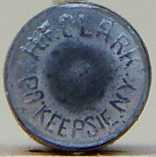 fairly common in the collecting journals and reference books. What
I have never seen pictured is the base of the bullet, an omission that I
have corrected here.
fairly common in the collecting journals and reference books. What
I have never seen pictured is the base of the bullet, an omission that I
have corrected here. 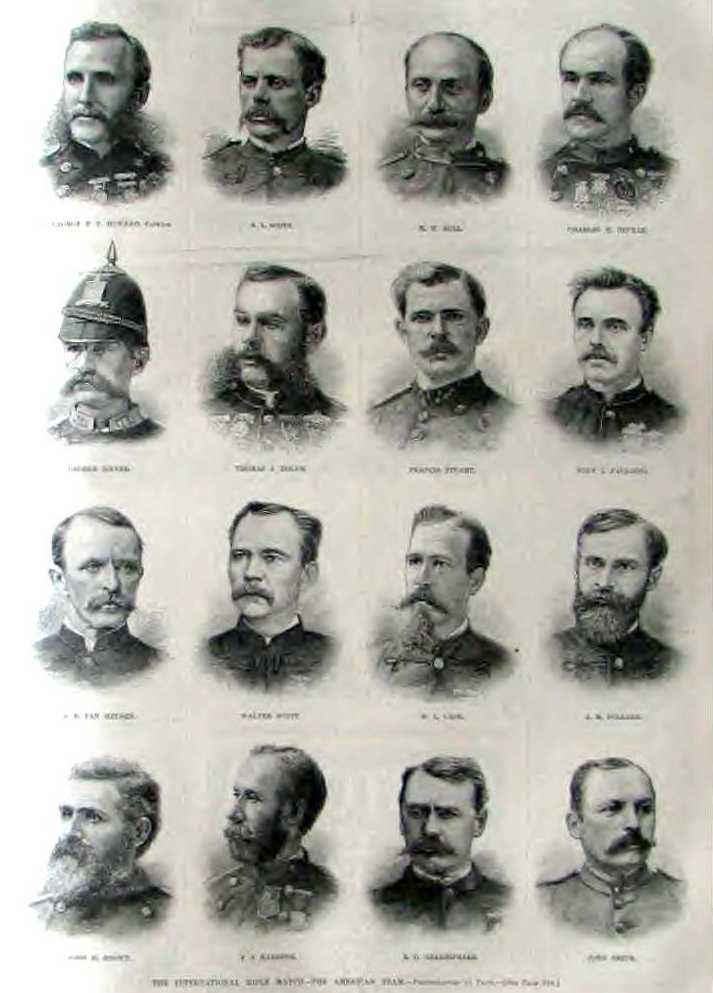 engraving of the 16 dapper members of the team that appeared in Harper's
Weekly in June of 1883. In addition to being skilled with a rifle, it would
appear that one prerequisite for consideration for a coveted spot on the
team was the ability to sport an abundance of facial hair, perhaps a
chauvinist ploy to minimize to some degree the possibility of having to deal
with female competitors.
engraving of the 16 dapper members of the team that appeared in Harper's
Weekly in June of 1883. In addition to being skilled with a rifle, it would
appear that one prerequisite for consideration for a coveted spot on the
team was the ability to sport an abundance of facial hair, perhaps a
chauvinist ploy to minimize to some degree the possibility of having to deal
with female competitors.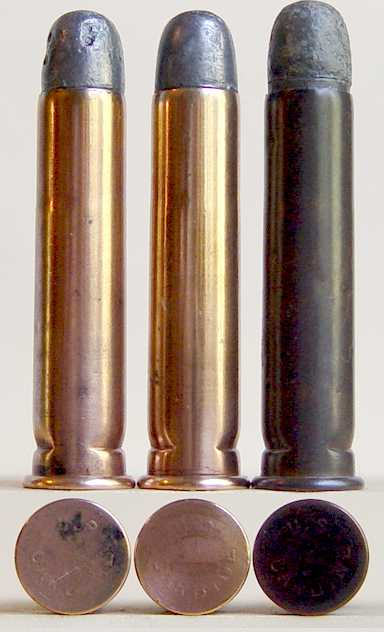
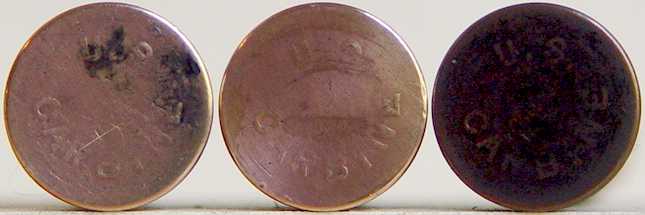 markings.
I realize that a single cartridge would have have been sufficient to
illustrate this headstamp, but I had never seen more than one of these at
any one time, so I couldn't resist sharing this picture of three that
managed to find themselves on my desk at the same time. Condition on these
cartridges tends also to be lacking. The bullets of every one that I have
seen have been a little dinged up; the one on the cartridge on the right in
the picture has been pushed out of the case about 1/8". This probably
resulted from the excess pressure exerted on the base of the bullet due to
the seven wads; in September of 1876, the number of wads used in the carbine
cartridges was reduced to five, specifically to reduce the pressure and
prevent the bullets from being dislodged. It should also be noted that it
wasn't until March of 1877 that the identification problem between rifle and
carbine cartridges was finally resolved, at which time all cartridges were
given headstamps, R F 3 77 for the rifle cartridges and C
F 3 77 for the carbine cartridges.
markings.
I realize that a single cartridge would have have been sufficient to
illustrate this headstamp, but I had never seen more than one of these at
any one time, so I couldn't resist sharing this picture of three that
managed to find themselves on my desk at the same time. Condition on these
cartridges tends also to be lacking. The bullets of every one that I have
seen have been a little dinged up; the one on the cartridge on the right in
the picture has been pushed out of the case about 1/8". This probably
resulted from the excess pressure exerted on the base of the bullet due to
the seven wads; in September of 1876, the number of wads used in the carbine
cartridges was reduced to five, specifically to reduce the pressure and
prevent the bullets from being dislodged. It should also be noted that it
wasn't until March of 1877 that the identification problem between rifle and
carbine cartridges was finally resolved, at which time all cartridges were
given headstamps, R F 3 77 for the rifle cartridges and C
F 3 77 for the carbine cartridges.